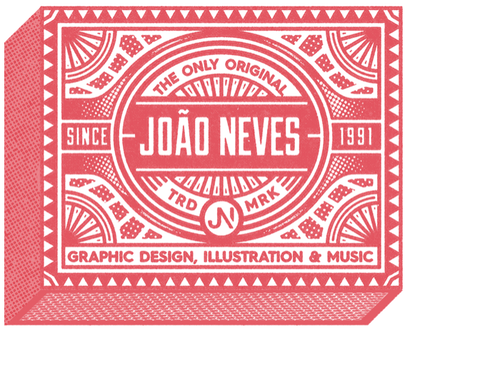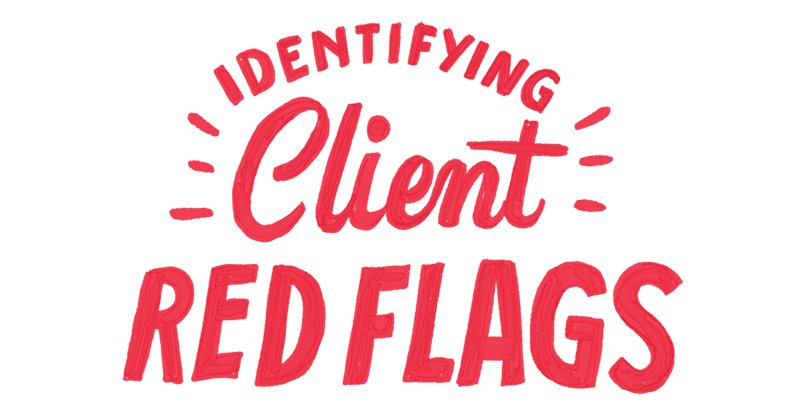If you ever worked as a freelancer you know that getting a new project inquiry is always exciting. This could be the time you’ll get the opportunity to work with a new fun client or to create something you’ve been wanting to add to your portfolio for a while. Unfortunately, the fact that someone contacted you doesn’t automatically mean you’re the best fit for them and vice versa. It’s not always easy to decipher someone’s intentions via the internet, but through the years I’ve learned to spot red flags when discussing potential projects that I believe helped me avoid some dodgy clients, projects and possible headaches.
In this post I’ll share some insights and tips on how to navigate situations where your work ethic and worth may be put to test. Please keep in mind that spotting red flags doesn’t automatically mean someone is a bad client and you shouldn’t work for them. A lot of the time clients are not fully aware of the work process and value a creative person can add to a project, so some of these sentences can simply come out of ignorance.
“The budget for this project is low but there’s a possibility of doing more work in the future”
Proposals like these come with the premise that doing this project for a discount fee could lead to more opportunities in the future. I never liked this approach because it always makes me think that if a client is not valuing my work now why would they do it after? Unless this is a project that you know from the start that you’ll be doing regularly (for example an illustration for a magazine that comes every other month) I would always take this premise with a grain of salt. It’s important to acknowledge that we might never hear from this type of client again because our only true guarantee is this initial project.
“Can you adapt this piece done by another artist?”
This one can be very tricky because a lot of times clients will share moodboards with other people’s work. That’s usually fine because it’s our job to find what’s compelling about those illustrations and then create something that suits this particular project and our style. But there can also be clients that flat out ask you to replicate another person’s work and that’s never ok. Fortunately that only happened to me a couple of times and, when the client showed no flexibility regarding style, I ended up redirecting the work to the original creators instead of accepting the project. Asking someone to copy another artist's work is not acceptable and the lack of ability to understand that is a major red flag.
“We don’t really know what we want”
As creators it’s our job to help clients creatively solve their problems, but those clients also have the responsibility to have a clear sense of direction and identity for us to be able to respond to their brief. While it might seem like a good opportunity to take full control of a project, clients that aren’t sure of what they're looking for are often the ones who say “I’ll know it when I see it”. This means you can either get lucky and get it right on the first round or do 10 different proposals and still not be able to satisfy the client. This often happens because they might be reaching out to you very early in the process of developing their project. Unfortunately we’re not miracle-makers who can respond to a brief with no direction, so my suggestion for situations like this is to propose delaying the start of the project until the client has a better foundation of the problems they’re trying to solve.
“Can you do a test run for us?”
There’s a combination of two words that really grinds my gears : spec work. In the agency world spec work is really common and, even though I still think it’s not a fair practice, it doesn’t hurt the creatives that much because they’re still getting paid. But, if you’re a freelancer, this type of practice means dedicating your time and services to something that might not come to fruition and can leave you empty handed. I strongly believe that as independent creators we have the responsibility and duty to charge for our services because we’re adding value to this client instead of dedicating our time to other possible paid projects.
A client can also ask you to do a test for them before committing to you, like a simple sketch or a concept board. While practices like this might seem harmless, agreeing to do them undervalues our work by offering free value to the client. Your experience and portfolio should speak for itself and if a client wants to collaborate you shouldn’t need to prove your worth.
“How much does it cost to do ___?”
I think this is the type of inquiry that I dislike the most and at the same time it’s also the most common. I understand that budget is usually the biggest limitation for potential clients but having a conversation start and end with “How much does X cost?” immediately makes me think that this client is only interested in cheap work. As designers, we can’t expect clients to be aware of our process and that’s why it’s also our job to educate them, but at the same time it’s also important for us to be appreciated for our work and not be treated as machines who can produce work for a certain amount of money. The fact that this type of client views creativity as a commodity always makes my radar go off and most of the time inquiries that start like this never end up progressing.
“We already worked with other designer/illustrators and we’re not happy”
I’ve had potential clients in the past disrespect previous designers in front of me. This is not only unprofessional but also makes me wonder if the problem was the designer or the client. While there’s a chance that the client was actually disappointed, having this toxic approach only shows immaturity and unprofessionalism and always makes me question if I want to work with someone like this.
“This is really easy and quick”
Having the client determine the difficulty and the duration of a task is rarely a good sign. This can be very subtle but you can spot it in sentences like “just a simple illustration” or “we want you to do something quick” . What this really means is that they’re undervaluing your work by making it look like a simple and effortless task. A good way to handle requests like this is explaining that the creative process is never simple and that there’s a lot happening behind the scenes that the client doesn’t know.
We talked about how to find reg flags during conversations with potential clients but what about green flags? From my experience I learned that a really good sign is when a client sends a detailed brief with clear instructions. It shows that they take their job seriously but also appreciate your time and craft. Another great sign is when a client respects your rates, even if it doesn’t meet their budget. An example is when they’re open to negotiating less rounds of revisions or fewer usage options.
What I learned through time is that even though some of these warning signs are a result of ignorance, we should trust our gut feeling to tell us if there’s trouble ahead. I don’t think a project should be canceled just because you’re faced with one of these examples. There’s always an opportunity to educate clients and avoid situations like this in the future for you and other creatives out there.
Did you ever come across any other red flag that I didn’t mention? Feel free to share your story in the comments!

